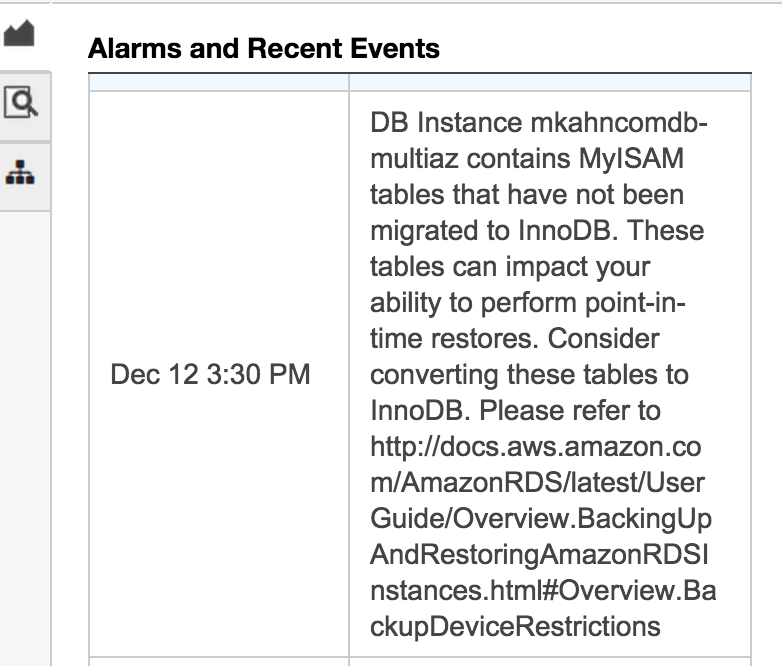So you’ve moved over your MySQL DB to RDS and you need to do some maintenance on it. Maybe you are noticing alerts in the RDS portal like this one

Maybe you are migrating an existing MySQL DB to RDS and its setup using the MyISAM DB engine. AWS recommends to only use the InnoDB storage engine so if you have a MySQL DB that has MyISAM you should consider converting those tables to InnoDB. Its okay if you do this after moving to RDS. AWS mentions that keeping MyISAM tables may lead to unreliable behavior when restoring from backups as MyISAM does not support reliable crash recovery.
In my case, I had already moved my WordPress DB to Amazon RDS. I do not have the DB publicly accessable and you shouldn’t either especially if the front end server is on ec2. If you are wondering about RDS security, Hexatier has a good article on securing Amazon RDS here. Keep in mind your RDS and EC2 security configuration when attempt to connect to do maintenance on your DB. My first
step was to connect to my EC2 instance in the same security group as my RDS DB to use the mysql client to modify the MyISAM tables.
To connect to a remote MySQL DB:
mysql -u dbusername -p -h dbhost
After connecting run this command to convert all dbname MyISAM Tables to InnoDB
SELECT CONCAT('ALTER TABLE ', TABLE_SCHEMA, '.', TABLE_NAME,' ENGINE=InnoDB;')
FROM Information_schema.TABLES WHERE TABLE_SCHEMA = 'dbname' AND ENGINE = 'MyISAM' AND TABLE_TYPE = 'BASE TABLE'
ref here
mysql> SELECT CONCAT('ALTER TABLE ', TABLE_SCHEMA, '.', TABLE_NAME,' ENGINE=InnoDB;')
-> FROM Information_schema.TABLES WHERE TABLE_SCHEMA = 'dbname' AND ENGINE = 'MyISAM' AND TABLE_TYPE = 'BASE TABLE'
-> ;
+--------------------------------------------------------------+
| |
+--------------------------------------------------------------+
| ALTER TABLE dbname.wp_commentmeta ENGINE=InnoDB; |
| ALTER TABLE dbname.wp_comments ENGINE=InnoDB; |
| ALTER TABLE dbname.wp_contact_form_7 ENGINE=InnoDB; |
| ALTER TABLE dbname.wp_links ENGINE=InnoDB; |
| ALTER TABLE dbname.wp_ngg_album ENGINE=InnoDB; |
| ALTER TABLE dbname.wp_ngg_gallery ENGINE=InnoDB; |
| ALTER TABLE dbname.wp_ngg_pictures ENGINE=InnoDB; |
| ALTER TABLE dbname.wp_options ENGINE=InnoDB; |
| ALTER TABLE dbname.wp_postmeta ENGINE=InnoDB; |
| ALTER TABLE dbname.wp_posts ENGINE=InnoDB; |
| ALTER TABLE dbname.wp_term_relationships ENGINE=InnoDB; |
| ALTER TABLE dbname.wp_term_taxonomy ENGINE=InnoDB; |
| ALTER TABLE dbname.wp_terms ENGINE=InnoDB; |
| ALTER TABLE dbname.wp_usermeta ENGINE=InnoDB; |
| ALTER TABLE dbname.wp_users ENGINE=InnoDB; |
+--------------------------------------------------------------+
So now just run the above MySQL commands to convert each table to InnoDB.
After converted in the event of a DB crash you should now be supported by the InnoDB DB engine reliable crash recovery feature.